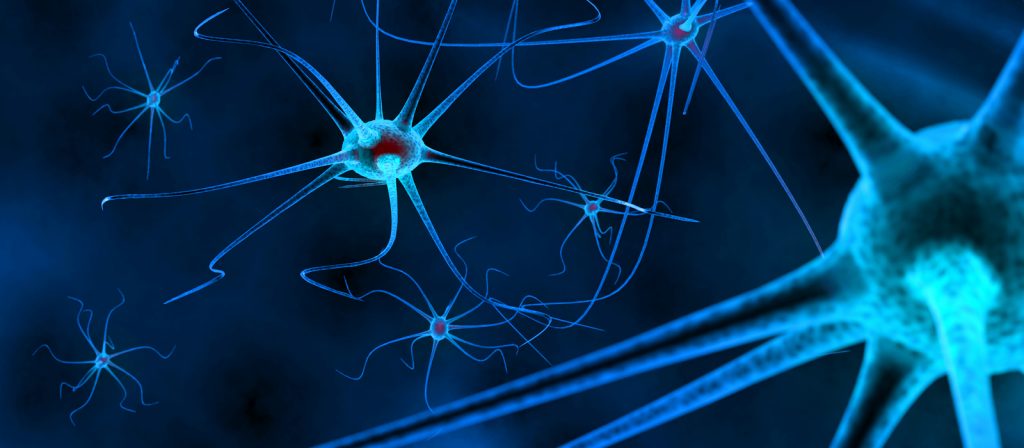
Table of Contents
Share
According to research by Harvard Business School professor Gerald Zaltman, about 95% of our purchasing decisions are governed by subconscious mental processes. As marketers, we know this theoretically. We've read dozens of studies advising us to appeal to the emotional, irrational, subconscious part of the brain.
Despite this knowledge being proven, the majority of marketing efforts are still focused on making logical appeals to a rational mind. This approach is suboptimal because it overlooks how the human brain actually functions, leading to a less than optimal user experience and low conversion rates.
So how can we effectively target the subconscious? First, we need to understand the nature of the decision-making process that occurs in the subconscious, including the role of emotions and the mechanisms that trigger our attention.
How Good is Our Subconscious at Making Decisions?
It's clear that decision-making is inherently 'biased.' Moreover, people generally make poor judgments. Research by Alex Pouget indicates that people often don't make the best decisions. Those who think they do are largely influenced by the subconscious, so their decisions are not rational.
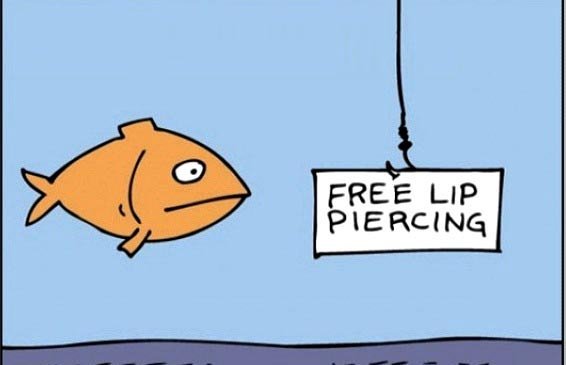
People trust their instincts because they often believe they are right. For example, if an offer seems too good and cheap, it is usually rejected. Neuromarketing research has discovered that our brain produces a positive emotion when it sees a good opportunity to achieve a goal. This physical process in the brain automatically triggers behavior to fulfill that goal.
On the other hand, our conscious mind, which we call system 2, is much more deliberative and conservative in thinking. We make rational decisions this way. As the number of things in our selective perception increases, our consciousness consumes more energy and quickly depletes.
The more complex your processes, the more you tire your customers' minds.
Therefore, digital marketers must be ruthless in removing clutter from a website or app and should not shy away from making bold moves to create an intuitive design. Sites with easy navigation and simple design do not over-activate System 2, preserving the user's mental energy. This makes the decision-making process easier.
We can't help but look at moving objects!
As a digital marketer, we should take advantage of moving objects but do so moderately. If the interface is shaking like the Harlem shake, the intended highlight will also be lost. The key is to control the visitor's perception and guide them according to our narrative without them realizing it.
Do We Buy What We Like? Or Do We Like What We Buy?
Neuroscience research by Gregory Berns and Sara Moore has shown that subjective liking has a weak effect on sales. According to the study, activating the brain's reward center is much more effective in leading a customer to make a purchase than subjective liking... So here's the truth: We tend to like what we buy; we don't necessarily buy what we like. Subconscious 2 - 0 Logic!
How Will We Target the Subconscious Mind?
To target the brain's subconscious, we must ensure that the product or brand aligns with implicit and psychological goals that activate our reward center. When this happens, we create an emotional response in the brain that leads to a quick decision.
What kind of expectations does our brain have? Although it seems complex, many of these are related to protecting us from harm (survival instinct) or forming strong social bonds. Indeed, our brain is focused on making decisions that optimize our chances of survival.
So far, we've established that there are powerful factors influencing our decision mechanism, and they are largely inexplicable by rational reasons. These variables, which we can call Hidden / Implicit Motives, directly influence our decisions and shape our lives.
We must now accept that a number of implicit motives influence our decision mechanism much more than we think.
Implicit motives determine which actions are rewarding and satisfying. Goals that do not align with implicit motives cannot strongly reflect feelings of reward or satisfaction. Another benefit of knowing visitors' implicit motivations is the possibility of adding targets in line with these motivations to your content, allowing for a stronger psychological proposition in engaging with visitors.
What are the Key Implicit Motives?
The marketing consultancy agency Beyond Reason combined insights from various psychological and neuroscience studies to develop the first comprehensive model of implicit motives. This model had eight overlapping motivational elements, later divided into four different motivation categories.
- Certainty
- Individuality
- Belonging
- Recognition (Appreciation)
- Physiology
- Sexuality
- Personal Development
- Power
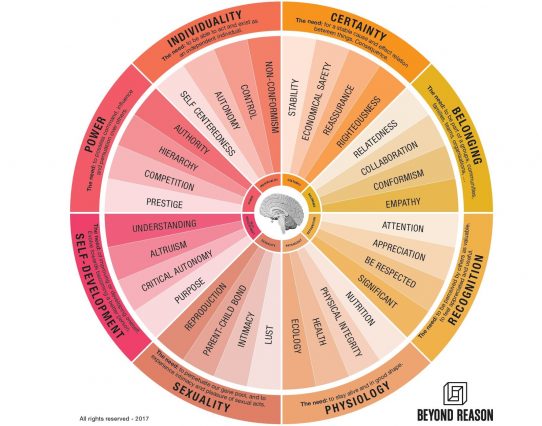
This model can prevent the ambiguity presented by many traditional behavior models. You can clearly learn how to craft messages to penetrate the subconscious mind from this model.
Using Hidden Motives in Marketing
Certainty
We hate uncertainty. If your brand can embody stability, trust, and accuracy, it will appeal to many customers. Especially since the internet is full of uncertainties, long-lasting and stable platforms have a significant advantage over unknown and unreliable ones. If you have such a feature, do not hesitate to express it.
Certainty is also extremely important in product features! Product name, price, dimensions, physical and technical characteristics, delivery time, shipping, and other conditions must be as enlightening as possible. Every piece of information you leave out will be filled in by the user through reasoning, which means more work for System 2. You know the rest of the story.
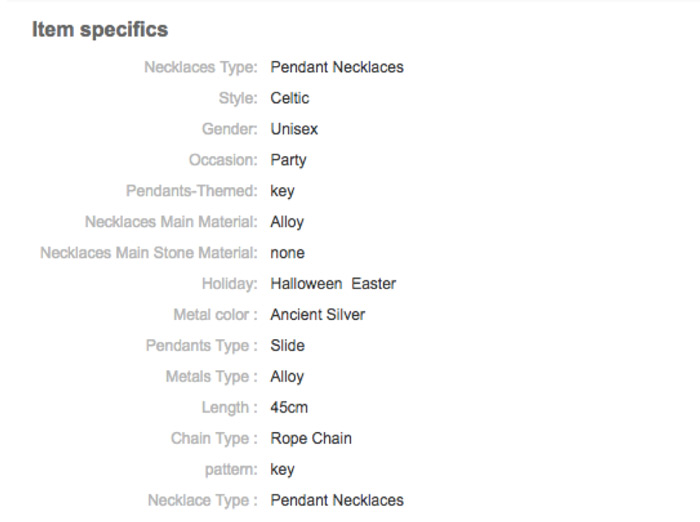

Belonging
Humans are highly social creatures and value being part of a group, community, or sect. This hidden motivation includes elements like relationships, cooperation, conformity, and empathy.
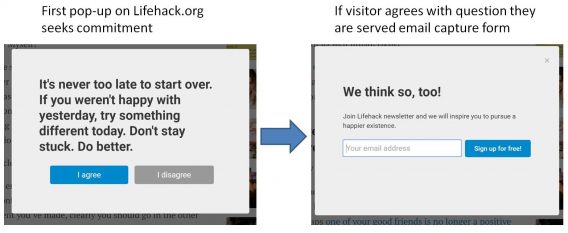
For example, https://www.lifehack.org/ uses the desire to conform to behavioral norms to persuade visitors to subscribe to its newsletter.
First, the visitor is asked a question they are likely to agree with. The visitor mostly agrees, establishing common ground. In the second stage, the visitor is offered newsletter membership. Having just agreed with Lifehack on a common point in the previous interaction, the visitor's likelihood of rejecting this offer decreases. As a result, a simple narrative significantly increases conversion rates.
Recognition
People want to be seen as valuable and appreciated by others. This involves being noticed by others, being respected, and reducing risk.
People want to see social proof that what they are doing is right. If you have a serious crowd supporting you, even if you are on the wrong path, you will think you are doing the right thing. Dictators emerge this way. J The same applies to shopping decisions. We tend to buy products used, recommended, and highly valued by others; thus, we confirm the correctness of our decision. Otherwise, we risk being seen as foolish and gullible, which no one wants.
Individuality
Individuality feeds on the thought of being independent. A person who acts according to their own will is strong and free. This involves being original, mastering one's own fate, and autonomy.
Airbnb, a major disruptive force in the accommodation and travel industry in recent years, has many great Airbnb stories circulating in the entrepreneurial ecosystem. One of my favorites is their section allowing people to share their travel and vacation experiences. People share their experiences, socialize, gain individual status, and others refer to these experiences... It motivates in every direction*
Power
Power is desired to influence and persuade others. It involves having authority, being at the top of the hierarchy, excelling in competition, and gaining prestige.
Gaming sites use power, mastery, and the desire to prove oneself by comparing with other players and leaderboards to motivate users. Many gaming companies allow users to play against their Facebook friends, set goals for players, and trigger a competitive environment.
I can confirm this as someone who experienced the early days of the Farmville craze. While everyone was leveling up under tough conditions, I outpaced everyone 5 times in 10 days with the help of a bot. I was bombarded with messages from friends and even visited by a cousin I hadn't seen in 5 years. It was powerful... It was fun...
Personal Development
It's related to a person's motivation for self-improvement. It triggers mechanisms such as altruism, self-questioning, causality, and utilitarianism. People want to see a benefit from every action they take because every benefit, whether material or spiritual, will positively reflect on their lives and change their conditions in their favor.
The decision to purchase is one of the moments when personal development and benefit expectations are at their highest!
Clearly stating the benefit to be gained from the purchased product or service will positively impact your sales. I've often used this example before; people don't want a 3mm drill bit, what they actually want is a 3mm hole! Whether you use clichés or develop new and interactive narratives doesn't matter. Identify the real need of the customer and offer a benefit accordingly.
Educational institutions sometimes use such examples. Saying "Our student A.....B..... chose us and became the 2nd in Turkey" is an example of this approach. A better example would be: "In 2016, 2510 out of 2522 students we educated were placed in a university..."
Sexuality
Sexuality is one of our most basic motivations because it ensures the continuation of our species. But there's more...
Research has shown that messages containing sexuality trigger thoughts related to intimacy, lust, and the mother-child bond in the subconscious.
Parents have a strong motivation to deepen their relationships with their children. Brands can convey this more effectively through images rather than words. However, using images that sell sexuality can also attract negative reactions from society. But this does not change the fact; sexuality sells, still sells, and will continue to sell. Using sexuality while being careful and hiding behind concepts like family-child-parent-love-romance can lead to success.
Brands like Levi’s, Abercrombie & Fitch, and Calvin Klein have been selling sexuality for years. Hundreds of global brands do it occasionally. Many brands, especially in the last 10 years, have been using the concept of family.
Physiology
Humans want to be physiologically healthy and strong as part of their survival instinct. This involves the desire for adequate nutrition, avoiding dangers, being healthy, and living in a clean environment. When you think about it, it touches on very broad mechanisms. (to survive ≥ to succeed ≥ to be strong, to be strong...)
This strategy can be used in many sectors, especially Health and Food.
Zombies Run Game, encourages a healthier and more active lifestyle using gamification and social proof. The app sets goals for users to exercise more frequently. It clearly states the benefits they will gain upon completion. It also allows users to create their own stories while walking or running. You're doing something good for yourself and proving it to others. Perfect.

How Can Digital Marketers Apply This Learning?
The human brain analyzes the difference between pain (e.g., price) and reward (benefit) when making a purchase decision.
When the difference is sufficiently large and the cost-benefit balance is positive, we are inclined to buy a product. The equation is very clear... There are 2 things you can do to increase the difference: Either improve the product's performance and increase the promised reward by enhancing the benefit; or reduce all kinds of costs incurred until the purchase, thereby reducing the pain.
Don't forget to simplify your processes in your work. It's a low-cost way to reduce the burden on the customer.
You can do this by rote, but it makes sense to start by understanding your customers' hidden motivations. What profile do your customers have? Do they want power, self-development, and individuality? What are their priorities? After determining this, ensure that these elements are reflected in your product, design, value proposition, texts, and even the way you provide service.
Check if you are creating inconsistency in your messages? If you can't align your messages with your users' expectations, a division will occur in communication by nature.
You also need to achieve internal harmony. You establish a communication strategy and adhere to it. When you succeed, you position yourself in the minds of customers as you wish. But if your statements contradict each other and keep changing, you start to be perceived as an unreliable brand. Ertuğrul Sağlam's words come to mind: Here's your positioning!
"They called us real men. We came like real men, worked like real men, and now we're leaving like real men."
Your primary goal should be to create messaging that appeals to System 1, the fast and intuitive brain. If you fail to do this, customers will move to the less effective System 2 in the sales process, which is a riskier area as you will face rationality tests, starting with price competition.
We can't say that the rational side should be completely eliminated. One of the important elements in the benefit and cost balance is, of course, the price!
Products meet our rational needs, while brands help us fulfill our psychological motivations.
“Writing is seeing the future.” Paul Valéry


